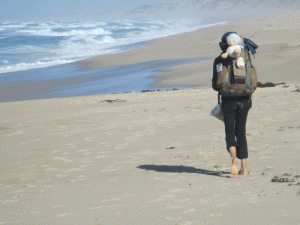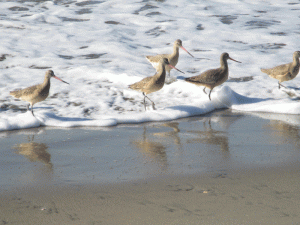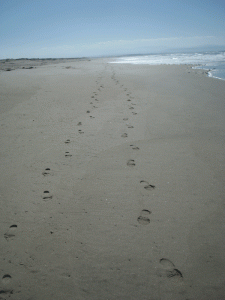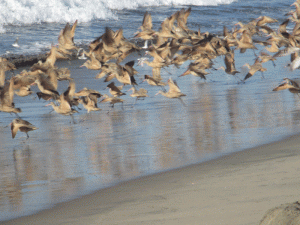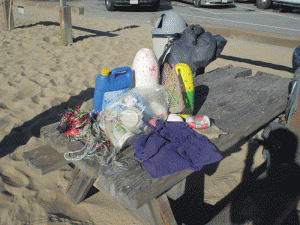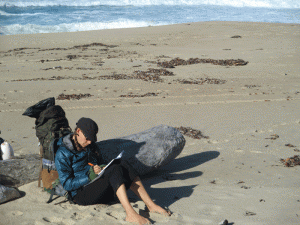- Death Valley’s Battle With Climate Extremes - 01/01/2024
- The Future of Homewood - 12/05/2023
- Kula Cloth - 10/18/2023
An epic waterline hike from Monterey to Santa Cruz
By Leonie Sherman
Once the scope of our historic drought dashed my hopes of an annual New Year’s ski tour, I caught a ride to Seaside State Beach, just north of Monterey, turned right and started walking. Three days later I climbed up the stairs at Pleasure Point in Capitola, in love with the wilderness in my own backyard.
Doug Peacock defines wilderness as a place where you can be eaten, and walking the Monterey Bay gives you a front row seat. You stroll the beach in perfect peace, while sharks and sea lions frolic less than a hundred yards away. There’s no chance you will be eaten, but real danger is perilously close.
Wilderness is also a state of mind and hiking the Monterey Bay – for half an hour or three days – can take you there. Two miles off shore and a mile below the surface is the least explored and understood place on the planet. All you can hear is the roar and crash of waves, even when Highway One is less than a mile away. A vast panorama stretches away to the western horizon, revealing the distant curve of our planet. The view to the east is dominated by coastal dunes, draped in brilliant ice plant with all the hues of an autumnal boreal forest.
The show is constant but never boring: a thin strip of sand that fades into creeping coastal fog. Monotony is rarely so dynamic – waves crash and recede, flecked with foam, spraying rainbows into the sky. The sun rises and sets, tinting the heaving waters with a thousand mercurial colors. Birds race the tide for tasty morsels and vanish in pulsing flocks. You place one foot in front of the other and move through it all. Every piece of driftwood is an invitation to sit and contemplate the vast spectacle.
This season’s epic drought brought a profusion of pelicans. For over two months these prehistoric mini dinosaurs haunted the Monterey Bay, unspooling in graceful skeins overhead, sunning themselves in solemn lines along sea cliffs and dive bombing just yards from shore in epic feeding frenzies. So as I hiked the beach towards home, I learned to identify half a dozen shore birds, watched sea lions and dolphins surf, and became a connoisseur of sand consistency.
If you want to follow in my footsteps for a memorable trip, big on beauty and low on risk, ditch the map, the watch, and your shoes. That’s right, you can hike barefoot on the beach for over thirty miles. (Maybe bring flip flops to get around Moss Landing.) Keep the ocean on your left. Follow the sand. Judge time by the sun, the slant of light on water, the lunar heave, and the pull of the tides.
Other coastal hikes I’ve done required desperate dawn starts to avoid rising tides around rocky points. But you can hike the Monterey Bay any time of day or night without even getting your feet wet. Except for the river crossings.
The Salinas and Pajaro Rivers together drain over 5500 square miles of land and can flow up to 95,000 cubic feet per second. When friends of mine hiked this stretch of wild coast one February, they faced chest deep wades and had to build an impromptu raft of driftwood tied together with shoelaces to ferry their belongings across the torrent.
But when I hiked the bay this past fall and early winter I didn’t have to cross those rivers. Not even a trickle. A hundred yard wide sand bar blocks their return to the ocean. The sand bar is a normal feature of summer and autumn, and gets wiped out by the first big storm. It’s a visceral reminder of drought to have a dry crossing this late into the “rainy season”.
On a full moon years ago I hiked from Manresa State Beach to the roiling Pajaro River and back, entranced by the light on the rippling dark waters. Along the way I passed rows of empty beach-side mansions. These are the second homes of the fortunate few, standing vacant most of the year, a potent symbol of the class divide in our crumbling economy.
But if the view belongs to the privileged few, the beach belongs to the people. Created over forty years ago, the California Coastal Commission works tirelessly to make sure that you and I can wander the beaches to our hearts content. They also strive to provide low cost visitor accommodations, manage commercial fisheries, preserve water quality and limit off shore oil and gas development. They receive no compensation for their work. Without them our coast would be a patchwork of private resorts and industrial disasters.
So as you hike the pristine public beaches between Monterey and Santa Cruz, give thanks to the hard working men and women of our Coastal Commission. And do your part to beautify our beaches by bringing along a trash bag and picking up the flotsam and jetsam that wash up on shore. You’ll be amazed at the variety of exotic junk that you find and feel virtuous for every piece of plastic you save from a watery fate. There are trash receptacles at every public beach you pass, so you don’t have to carry anything for very long.
This adventure and beauty comes with shockingly little risk. You can hike the bay as several leisurely day hikes or backpack over forty miles from Lovers Point, just south of Monterey, to Pleasure Point, just south of Santa Cruz. There are six state beaches between Aptos and Monterey, all with road access and four with running water. When the harbor forces you to step onto pavement at Moss Landing you can also stop in for fish tacos and beer. Accommodations range from luxurious hotels to camping at state parks.
I took three days, two nights for my trip and hiked 6-8 hours each day, with ample breaks. I have no idea how many miles I covered. I carried enough food and gear to survive a minor mountaineering epic, which was total overkill; you can complete this hike armed with snacks and a credit card. Plan to carry two or three liters of water and chuckle as you refill your bottles at taps available along the way.
However you go, wherever you start or finish, you’ll find that there you are, engulfed by morning fog, watching the bay slip away and charting progress by motion rather than miles. Idle chatter drops away. And you’ll remember your common heritage with each animal walking, flying or slithering across the planet: we all carry the ocean in our veins.

